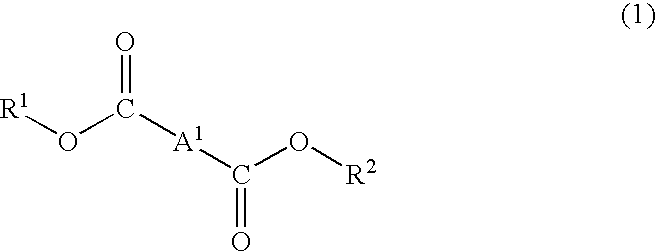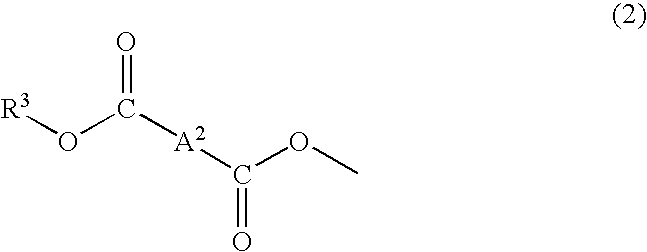Transparent composite material
a composite material and transparent technology, applied in the field of transparent composite materials, can solve the problems of further generation of disconnection and increase of resistance, and achieve the effects of increasing resistance, high-durability display devices, and useful industrially
- Summary
- Abstract
- Description
- Claims
- Application Information
AI Technical Summary
Benefits of technology
Problems solved by technology
Method used
Image
Examples
synthesis example 1
[0182]In a 2L-volume three-neck flask equipped with a distillation unit, 1625 g of diallyl 1,4-cyclohexane dicarboxylate, 327 g of propylene glycol and 0.813 g of dibutyl tin oxide were placed. The mixture was heated under nitrogen stream while distilling off generated allylalcohol at 180° C. At the time point when the amount of the distilled allylalcohol reached about 350 g, the inside of the reaction system was depressurized gradually to 6.6 kPa (over about 4 hours) to accelerate the distillation rate of alcohol. At the time point when almost no distilled liquid coming out was observed, the inside of the reaction system was depressurized to 0.5 kPa and reaction was continued for another 1 hour. Then the reaction product was cooled down. Hereinafter, the thus obtained reaction product is called “oligomer (1)”.
synthesis example 2
[0183]In a 2L-volume three-neck flask equipped with a distillation unit, 1400 g of diallyl 1,4-cyclohexanedicarboxylate, 165.4 g of trimethylolpropane and 1.40 g of dibutyl tin oxide were placed. The mixture was heated under nitrogen stream while distilling off generated alcohol at 180° C. At the time point when the amount of the distilled alcohol became about 150 g, the inside of the reaction system was depressurized gradually to 6.6 kPa over about 4 hours to accelerate the distillation rate of alcohol. At the time point when almost no distilled liquid coming out was observed, the inside of the reaction system was depressurized to 0.5 kPa and reaction was continued for another 1 hour. Then the reaction product was cooled down. Hereinafter, the thus obtained reaction product is called “oligomer (2)”.
synthesis example 3
[0184]In a 2L-volume three-neck flask equipped with a distillation unit, 1625 g of diallyl terephthalate, 167 g of propylene glycol and 0.813 g of dibutyl tin oxide were placed. The mixture was heated under nitrogen stream while distilling off generated alcohol at 180° C. At the time point when the amount of the distilled alcohol reached about 170 g, the inside of the reaction system was depressurized gradually to 6.6 kPa over about 4 hours to accelerate the distillation rate of alcohol. At the time point when almost no distilled liquid coming out was observed, the inside of the reaction system was depressurized to 0.5 kPa and reaction was continued for another 1 hour. Then the reaction product was cooled down. Hereinafter, the thus obtained reaction product is called “oligomer (3)”.
PUM
| Property | Measurement | Unit |
|---|---|---|
| number-average particle size | aaaaa | aaaaa |
| aspect ratio | aaaaa | aaaaa |
| total transmittance | aaaaa | aaaaa |
Abstract
Description
Claims
Application Information
 Login to View More
Login to View More - R&D
- Intellectual Property
- Life Sciences
- Materials
- Tech Scout
- Unparalleled Data Quality
- Higher Quality Content
- 60% Fewer Hallucinations
Browse by: Latest US Patents, China's latest patents, Technical Efficacy Thesaurus, Application Domain, Technology Topic, Popular Technical Reports.
© 2025 PatSnap. All rights reserved.Legal|Privacy policy|Modern Slavery Act Transparency Statement|Sitemap|About US| Contact US: help@patsnap.com



